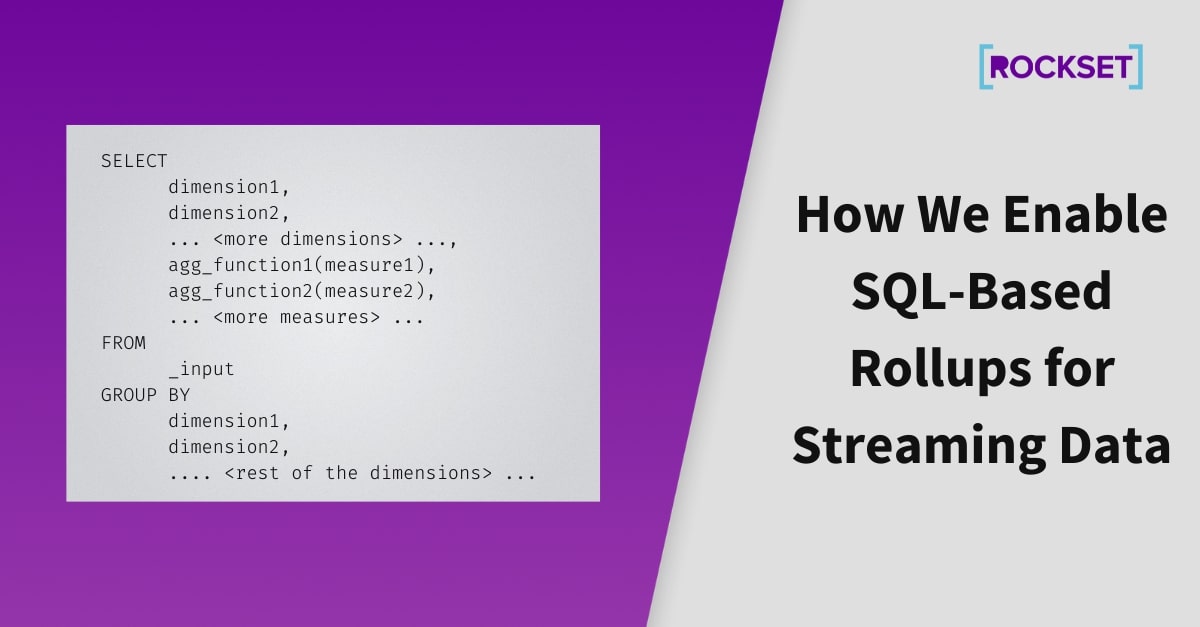Till Now: The Sluggish Crawl from Batch to Actual-Time Analytics
The world is shifting from batch to real-time analytics however it’s been at a crawl. Apache Kafka has made buying real-time knowledge extra mainstream, however solely a small sliver are turning batch analytics, run nightly, into real-time analytical dashboards with alerts and computerized anomaly detection. The bulk are nonetheless draining streaming knowledge into a knowledge lake or a warehouse and are doing batch analytics. That’s as a result of conventional OLTP methods and knowledge warehouses are ill-equipped to energy real-time analytics simply or effectively. OLTP methods aren’t suited to deal with the dimensions of real-time streams and are not constructed to serve complicated analytics. Warehouses wrestle to serve recent real-time knowledge and lack the pace and compute effectivity to energy real-time analytics. It turns into prohibitively complicated and costly to make use of a knowledge warehouse to serve real-time analytics.
Rockset: Actual-time Analytics Constructed for the Cloud
Rockset is doing for real-time analytics what Snowflake did for batch. Rockset is a real-time analytics database within the cloud that makes use of an indexing strategy to ship low-latency analytics at scale. It eliminates the associated fee and complexity round knowledge preparation, efficiency tuning and operations, serving to to speed up the motion from batch to real-time analytics.
The most recent Rockset launch, SQL-based rollups, has made real-time analytics on streaming knowledge much more reasonably priced and accessible. Anybody who is aware of SQL, the lingua franca of analytics, can now rollup, rework, enrich and mixture real-time knowledge at large scale.
In the remainder of this weblog publish, I’ll go into extra element on what’s modified with this launch, how we carried out rollups and why we expect that is essential to expediting the real-time analytics motion.
A Fast Primer on Indexing in Rockset
Rockset permits customers to attach real-time knowledge sources — knowledge streams (Kafka, Kinesis), OLTP databases (DynamoDB, MongoDB, MySQL, PostgreSQL) and in addition knowledge lakes (S3, GCS) — utilizing built-in connectors. Whenever you level Rockset at an OLTP database like MySQL, Postgres, DynamoDB, or MongoDB, Rockset will first do a full copy after which reduce over to the CDC stream robotically. All these connectors are real-time connectors so new knowledge added to the supply or INSERTS/UPDATES/DELETES in upstream databases will probably be mirrored in Rockset inside 1-2 seconds. All knowledge will probably be listed in real-time, and Rockset’s distributed SQL engine will leverage the indexes and supply sub-second question response instances.
However till this launch, all these knowledge sources concerned indexing the incoming uncooked knowledge on a file by file foundation. For instance, when you linked a Kafka stream to Rockset, then each Kafka message would get totally listed and the Kafka subject could be become totally typed, totally listed SQL desk. That’s adequate for some use instances. Nonetheless, for a lot of use instances at big volumes — equivalent to a Kafka subject that streams tens of TBs of information on daily basis — it turns into prohibitively costly to index the uncooked knowledge stream after which calculate the specified metrics downstream at question processing time.
Opening the Streaming Gates with Rollups
With SQL-based Rollups, Rockset means that you can outline any metric you need to observe in real-time, throughout any variety of dimensions, merely utilizing SQL. The rollup SQL will act as a standing question and can constantly run on incoming knowledge. All of the metrics will probably be correct as much as the second. You should use all the facility and suppleness of SQL to outline complicated expressions to outline your metric.
The rollup SQL will usually be of the shape:
SELECT
dimension1,
dimension2,
... <extra dimensions> ...,
agg_function1(measure1),
agg_function2(measure2),
... <extra measures> ...
FROM
_input
GROUP BY
dimension1,
dimension2,
.... <remainder of the scale> ...
You too can optionally use WHERE clauses to filter out knowledge. Since solely the aggregated knowledge is now ingested and listed into Rockset, this system reduces the compute and storage required to trace real-time metrics by just a few orders of magnitude. The ensuing aggregated knowledge will get listed in Rockset as typical, so it’s best to count on actually quick queries on prime of those aggregated dimensions for any sort of slicing/dicing evaluation you need to run.
SQL-Primarily based Rollups Are 🔥
Sustaining real-time metrics on easy aggregation features equivalent to SUM() or COUNT() are pretty simple. Any bean-counting software program can do that. You merely have to use the rollup SQL on prime of incoming knowledge and rework a brand new file right into a metric increment/decrement command, and off you go. However issues get actually attention-grabbing when it’s essential to use a way more complicated SQL expression to outline your metric.
Check out the error_rate and error_rate_arcsinh [1] metrics within the following real-world instance:
SELECT
service provider,
operation,
event_date,
EXTRACT(hour from event_date) as event_hour,
EXTRACT(minute from event_date) as event_min,
COUNT(*) as event_count,
(CASE
WHEN depend(*) = 0 THEN 0
ELSE sum(error_flag) * 1.0 / depend(*)
END) AS error_rate,
LOG10(
(CASE
WHEN depend(*) = 0 THEN 0
ELSE sum(error_flag) * 1.0 / sum(event_count)
END)
+ SQRT(POWER(CASE
WHEN depend(*) = 0 THEN 0
ELSE sum(error_flag) * 1.0 / sum(event_count)
END, 2) + 1)
) AS error_rate_arcsinh
FROM
_input
GROUP BY
service provider,
operation,
event_date,
event_hour,
event_min
Sustaining the error_rate and error_rate_arcsinh in real-time shouldn’t be so easy. The operate doesn’t simply decompose into easy increments or decrements that may be maintained in real-time. So, how does Rockset help this you’ll marvel? Should you look intently at these two SQL expressions, you’ll understand that each these metrics are doing fundamental arithmetic on prime of two easy mixture metrics: depend(*) and sum(error_flag). So, if we will keep these two easy base mixture metrics in real-time after which plug within the arithmetic expression at question time, then you possibly can all the time report the complicated metric outlined by the person in real-time.
When requested to take care of such complicated real-time metrics, Rockset robotically splits the rollup SQL into 2 components:
- Half 1: a set of base mixture metrics that truly have to be maintained at knowledge ingestion time. In instance above, these base mixture metrics are
depend(*)andsum(error_flag). For sake of understanding, assume these metrics are tracked as_countand_sum_error_flagrespectively.
depend(*) as _count
sum(error_flag) as _sum_error_flag
- Half 2: the set of expressions that have to be utilized on prime of the pre-calculated base mixture metrics at question time. Within the instance above, the expression for error_rate would look as follows.
(CASE
WHEN _count = 0 THEN 0
ELSE _sum_error_flag * 1.0 / :depend
END) AS error_rate
So, now you need to use the total breadth and suppleness accessible in SQL to assemble the metrics that you just need to keep in real-time, which in flip makes real-time analytics accessible to your complete workforce. No must study some archaic area particular language or fumble with complicated YAML configs to realize this. You already know find out how to use Rockset as a result of you understand how to make use of SQL.
Correct Metrics in Face of Dupes and Late Comers
Rockset’s real-time knowledge connectors assure exactly-once semantics for streaming sources equivalent to Kafka or Kinesis out of the field. So, transient hiccups or reconnects aren’t going to have an effect on the accuracy of your real-time metrics. This is a crucial requirement that shouldn’t be missed whereas implementing a real-time analytical answer.
However what’s much more necessary is find out how to deal with out-of-order arrivals and late arrivals that are very quite common in knowledge streams. Fortunately, Rockset’s indexes are totally mutable on the area degree not like different methods equivalent to Apache Druid that seals older segments which makes updating these segments actually costly. So, late and out-of-order arrivals are trivially easy to take care of in Rockset. When these occasions arrive, Rockset will course of them and replace the required metrics precisely as if these occasions truly arrived in-order and on-time. This eliminates a ton of operational complexity for you whereas making certain that your metrics are all the time correct.
Now: The Quick Flight from Batch to Actual-Time Analytics
You may’t introduce streaming knowledge right into a stack that was constructed for batch. You’ll want to have a database that may simply deal with large-scale streaming knowledge whereas persevering with to ship low latency analytics. Now, with Rockset, we’re in a position to ease the transition from batch to real-time analytics with an reasonably priced and accessible answer. There’s no must study a brand new question language, therapeutic massage knowledge pipelines to reduce latency or simply waste/throw lots of compute at a batch-based system to get incrementally higher efficiency. We’re making the transfer from batch to real-time analytics so simple as setting up a SQL question.
You may study extra about this launch in a stay interview we did with Tudor Bosman, Rockset’s Chief Architect.
Embedded content material: https://youtu.be/bu5MRzd8d-0
References:
[1] If you’re questioning who wants to take care of inverse hyperbolic sine features on error charges, then clearly you haven’t met an econometrician these days.
Utilized econometricians typically rework variables to make the interpretation of empirical outcomes simpler, to approximate a traditional distribution, to cut back heteroskedasticity, or to cut back the impact of outliers. Taking the logarithm of a variable has lengthy been a preferred such transformation.
One drawback with taking the logarithm of a variable is that it doesn’t permit retaining zero-valued observations as a result of ln(0) is undefined. However financial knowledge typically embrace significant zero-valued observations, and utilized econometricians are usually loath to drop these observations for which the logarithm is undefined. Consequently, researchers have typically resorted to advert hoc technique of accounting for this when taking the pure logarithm of a variable, equivalent to including 1 to the variable previous to its transformation (MaCurdy and Pencavel, 1986).
Lately, the inverse hyperbolic sine (or arcsinh) transformation has grown in reputation amongst utilized econometricians as a result of (i) it’s just like a logarithm, and (ii) it permits retaining zero-valued (and even negative- valued) observations (Burbidge et al., 1988; MacKinnon and Magee, 1990; Pence, 2006).
Supply: https://marcfbellemare.com/wordpress/wp-content/uploads/2019/02/BellemareWichmanIHSFebruary2019.pdf

